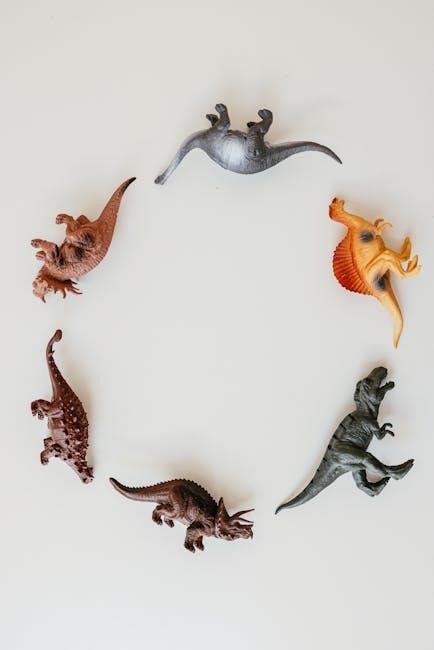Dinosaurs were fascinating prehistoric creatures that dominated Earth during the Mesozoic Era, showcasing incredible diversity in size, shape, and behavior․ Their study reveals insights into life’s evolution and extinction․
1․1 Definition and Historical Context
Dinosaurs were terrestrial reptiles that dominated Earth’s landscapes during the Mesozoic Era, lasting over 150 million years․ The term “dinosaur” was coined by Sir Richard Owen in 1842, derived from Greek words meaning “terrible lizard․” They exhibited remarkable diversity in size, behavior, and adaptations, with their fossils providing critical insights into Earth’s ancient ecosystems and evolutionary history․
1․2 Significance in Earth’s History
Dinosaurs played a pivotal role in shaping Earth’s ecosystems during the Mesozoic Era, exemplifying evolutionary adaptability and diversity․ Their dominance spanned over 150 million years, influencing flora, fauna, and environmental changes․ The study of dinosaurs provides profound insights into evolutionary biology, paleoecology, and the Earth’s past, making them a cornerstone of scientific and historical inquiry․

The Mesozoic Era
The Mesozoic Era, spanning approximately 185 million years, is often called the Age of Dinosaurs․ It is divided into the Triassic, Jurassic, and Cretaceous periods, each marked by the evolution and diversification of dinosaurs, ultimately ending with their extinction in a mass event that reshaped Earth’s history․
2․1 Triassic Period
The Triassic Period, spanning 252–201 million years ago, marked the rise of dinosaurs․ Early dinosaurs emerged among archosaurs, evolving into diverse forms․ Ecosystems ranged from arid deserts to lush forests, fostering the development of reptiles and synapsids․ Key species like Eoraptor and Herrerasaurus exemplified the period’s transitional biodiversity, setting the stage for dinosaur dominance in subsequent eras․
2․2 Jurassic Period
The Jurassic Period, spanning 200–145 million years ago, is often called the “Golden Age” of dinosaurs․ Iconic species like Brachiosaurus and Allosaurus thrived in diverse ecosystems, from lush forests to vast plains․ This era saw the evolution of both herbivorous and carnivorous giants, while early mammals and crocodilians coexisted․ By its end, many classic dinosaur forms had emerged, shaping the Mesozoic landscape․
2․3 Cretaceous Period
The Cretaceous Period, lasting from 145 to 66 million years ago, saw flowering plants dominate landscapes, alongside hadrosaurs, tyrannosaurs, and ceratopsians․ This era also hosted diverse marine reptiles and early birds․ The Cretaceous ended abruptly with a mass extinction event, likely caused by an asteroid impact, wiping out all non-avian dinosaurs and marking the end of the Mesozoic Era․
Classification of Dinosaurs
Dinosaurs are classified into two main groups: Saurischia and Ornithischia․ Saurischia includes theropods and sauropodomorphs, while Ornithischia encompasses armored dinosaurs and ornithopods, reflecting their physical traits and ancestry․
3․1 Saurischia and Ornithischia
Dinosaurs are primarily classified into Saurischia and Ornithischia, based on hip structure․ Saurischians, like theropods and sauropodomorphs, have a “reptilian” hip․ Ornithischians, including armored and horned dinosaurs, exhibit a “bird-like” hip․ These groups reflect distinct evolutionary paths, shaping their physical traits and ecological roles during the Mesozoic Era․
3;2 Key Characteristics and Groupings
Dinosaurs are grouped by shared traits like body size, diet, and locomotion․ Sauropods were massive herbivores with long necks, while ceratopsians had distinctive crests․ Armored dinosaurs like ankylosaurs had protective plates, and theropods, including birds, were primarily carnivorous․ These groupings highlight adaptability, with features like specialized teeth, powerful limbs, and unique skin coverings defining their ecological roles․
Physical Characteristics
Dinosaurs exhibited remarkable diversity in size and skeletal structure, with adaptations for speed or strength․ Many had feathers or scales, while others displayed specialized claws and teeth․
4․1 Size and Skeletal Structure
Dinosaurs varied greatly in size, from small, feathered creatures to massive, long-necked sauropods․ Their skeletal structures were adapted for specific lifestyles, with hollow bones in many species for lightweight mobility and robust frames in others for strength and support․ These adaptations highlight their remarkable diversity and evolutionary specialization․
4․2 Feathers and Skin Coverings
Fossil evidence reveals that many dinosaurs, particularly theropods, were covered in feathers․ These feathers likely served multiple purposes, including insulation, display, and aiding in flight for some species․ Other dinosaurs had scaly skin, which provided protection and supported their body structures․ These coverings played crucial roles in their survival and adaptation to various environments․
4․3 Claws and Teeth
Dinosaurs had highly adapted claws and teeth suited to their diets and lifestyles․ Carnivorous dinosaurs, like Velociraptor, featured sharp, curved claws for hunting, while herbivores, such as Stegosaurus, had broad, grinding teeth for plant material․ These specialized features were essential for survival, reflecting their ecological roles and dietary needs during the Mesozoic Era․
Dinosaur Behavior
Dinosaurs exhibited diverse behaviors, including herding and nesting, while predator-prey interactions shaped their survival strategies, offering insights into their social structures and adaptability during the Mesozoic Era․
5․1 Herbivores and Carnivores
Dinosaurs were primarily divided into herbivores and carnivores․ Herbivores, like Sauroposeidon, fed on plants, while carnivores, such as Tyrannosaurus Rex, hunted other animals for survival․ Herbivores often had specialized teeth for grinding vegetation, whereas carnivores evolved sharp, serrated teeth for tearing flesh․ This dietary divide shaped their physical adaptations and ecological roles, influencing their evolution and extinction patterns over time․
5․2 Herding and Social Behavior
Fossil evidence suggests many dinosaurs exhibited herding behavior, likely for protection, migration, and mating․ Herbivores like Iguanodon and Hadrosaurus often moved in groups, while some carnivores may have hunted cooperatively․ Track marks and nesting sites indicate complex social interactions, showcasing that dinosaurs were not solitary creatures but thrived in communal settings, enhancing their survival and reproductive success significantly․
5․3 Nesting and Reproduction
Dinosaurs exhibited complex nesting behaviors, with many species laying eggs in structured nests․ Fossil evidence shows some dinosaurs, like Oviraptor, brooded their eggs, while others, such as Maiasaura, likely nested in colonies․ These findings suggest dinosaurs had varying reproductive strategies, some displaying parental care, which provides insights into their social and reproductive behaviors across different species․

Scientific Naming and Classification
Dinosaurs are scientifically named using binomial nomenclature, a two-part system of genus and species․ Classification follows taxonomic hierarchies, organizing species into broader groups based on shared traits and ancestry․
6․1 Binomial Nomenclature
Binomial nomenclature assigns species a two-part name: genus and species․ For example, Tyrannosaurus rex combines genus Tyrannosaurus with species rex․ This system, introduced by Carl Linnaeus, ensures universal scientific communication, providing clarity and consistency in dinosaur taxonomy, allowing researchers to identify and classify species accurately across the globe, facilitating comparative studies and understanding evolutionary relationships effectively․
6․2 Taxonomic Hierarchies
Taxonomic hierarchies organize dinosaurs into a structured classification system, starting from broad categories like Kingdom (Animalia) and Phylum (Chordata) down to specific groups․ Orders, families, genera, and species provide a framework for understanding relationships․ For example, Tyrannosaurus rex belongs to the family Tyrannosauridae, reflecting its evolutionary connections․ This system aids in studying diversity and ancestral links among dinosaurs․
Fossilization and Excavation
Fossilization preserves dinosaur remains through mineral replacement, while excavation involves careful digging and extraction by paleontologists․ Proper techniques ensure fossils are recovered intact, aiding scientific study and understanding․
7․1 Fossil Formation Process
Fossil formation requires specific conditions: rapid burial, protection from scavengers, and mineral-rich environments․ Over time, original organic material is replaced with minerals, creating detailed impressions of bones, skin, or even feathers․ This process preserves dinosaur remains, offering scientists a window into prehistoric life and aiding in the reconstruction of ancient ecosystems and species behaviors․
7․2 Notable Fossil Discoveries
Significant dinosaur fossils, such as Sue (Tyrannosaurus rex) and Lucy (Australopithecus), have reshaped our understanding of prehistoric life․ The discovery of Archaeopteryx bridged dinosaurs and birds, while Spinosaurus revealed unique adaptations․ Fossils like Velociraptor with quill knobs confirmed feathered dinosaurs, revolutionizing paleontology and public fascination with these ancient creatures․
Well-Known Dinosaurs
Well-known dinosaurs like Tyrannosaurus Rex, Velociraptor, Diplodocus, Stegosaurus, and Triceratops captivate audiences with their unique traits, from fearsome predators to gentle herbivores, each playing a distinct role in the ancient world․
8․1 Tyrannosaurus Rex and Velociraptor
Tyrannosaurus Rex, a massive carnivore, was known for its powerful legs and strong bite force․ Velociraptor, smaller but highly intelligent, hunted in packs using sharp claws․ Both were apex predators, showcasing adaptability and dominance in their environments, leaving lasting impressions in paleontology and popular culture․
8․2 Diplodocus and Stegosaurus
Diplodocus, a long, herbivorous sauropod, was known for its slender build and small head․ Stegosaurus, another plant-eater, featured distinctive row of plates on its back and spikes on its tail for defense․ Both thrived during the Jurassic Period, showcasing unique adaptations that allowed them to coexist and dominate their ecosystems effectively․
8․3 Triceratops and Cretaceous Species
Triceratops, a horned herbivore, roamed North America during the Late Cretaceous․ Its distinctive frill and horns likely served for defense and display․ Other Cretaceous species included armored Ankylosaurus and duck-billed Hadrosaurus, showcasing the diversity of herbivores․ Carnivores like Tyrannosaurus rex dominated, while feathered theropods hinted at bird-like evolution, highlighting the complexity of late dinosaur ecosystems․
Dinosaur Intelligence and Behavior
Dinosaurs exhibited varying levels of intelligence, with some species showing problem-solving abilities and complex social behaviors․ Evidence suggests herding, communication, and adaptive predator-prey strategies, indicating resourceful and dynamic creatures․
9․1 Problem-Solving Abilities
Dinosaurs demonstrated problem-solving skills through nesting strategies, tool use, and adaptive behaviors․ Some species, like theropods, used stones for nesting, while others exhibited complex herding and migratory patterns, showcasing their cognitive abilities and resourcefulness in their environments․
9․2 Predator-Prey Relationships
Dinosaur predators, like Tyrannosaurus Rex and Velociraptor, evolved sharp claws and powerful bites to hunt prey․ Herbivores, such as Hadrosaurus and Triceratops, developed armor plates and herding behaviors for defense․ These interactions drove evolutionary adaptations, shaping the diversity of species and their survival strategies in a competitive ecosystem․
Extinction Theories
The dominant theory suggests a massive asteroid impact caused the dinosaurs’ extinction, while others propose volcanic eruptions or climate change․ Both factors likely contributed to their demise․
10;1 Asteroid Impact Theory
The asteroid impact theory proposes a massive asteroid struck Earth, causing catastrophic environmental changes․ This 10-kilometer-wide asteroid, impacting near Chicxulub, Mexico, triggered earthquakes, tsunamis, and volcanic eruptions․ The resulting dust and debris blocked sunlight, leading to a “nuclear winter” and the collapse of ecosystems, ultimately causing dinosaur extinction․ Evidence includes the Chicxulub crater and iridium-rich sediment layers․
10․2 Volcanic Activity and Climate Change
Massive volcanic eruptions, such as the Deccan Traps in India, released large amounts of CO2, leading to significant climate change․ This caused rising temperatures, acid rain, and disrupted ecosystems, making habitats inhospitable for many dinosaur species․ Such environmental stress, combined with other factors like asteroid impacts, likely contributed to their extinction, offering a multi-causal explanation for the dinosaurs’ demise․

Dinosaurs in Popular Culture
Dinosaurs captivate audiences through movies, documentaries, and museum exhibits, inspiring wonder and curiosity․ Their enduring appeal fuels creative storytelling, education, and scientific interest, shaping cultural perceptions globally․
11․1 Movies, Books, and Media
Dinosaurs captivate audiences in films like Jurassic Park and The Good Dinosaur, while books such as Michael Crichton’s Jurassic Park blend science with storytelling․ Documentaries like Walking with Dinosaurs and media, including video games, continue to inspire and educate, keeping dinosaurs relevant in modern entertainment and cultural discourse․
11․2 Cultural Significance and Fascination
Dinosaurs hold a special place in human culture, symbolizing both wonder and awe․ They inspire art, toys, and public imagination, bridging science and entertainment․ Their enduring appeal reflects humanity’s curiosity about prehistoric life and the natural world, making them a timeless symbol of fascination and discovery across generations․
Dinosaurs, as fascinating creatures, shaped Earth’s history, showcasing life’s diversity and resilience․ Their extinction remains a mystery, inspiring scientific curiosity and public awe, encouraging further exploration and learning about prehistoric life․
12․1 Summary of Key Points
Dinosaurs dominated Earth’s landscapes during the Mesozoic Era, showcasing remarkable diversity in size, behavior, and adaptation․ Their extinction, likely due to an asteroid impact, remains a scientific mystery․ These creatures have captivated human imagination, inspiring research, education, and popular culture, leaving a lasting legacy that continues to fuel exploration and learning about prehistoric life․
12․2 Encouragement for Further Learning
The study of dinosaurs offers a gateway to understanding Earth’s history, evolution, and life sciences․ Explore reputable sources like museum websites, documentaries, and books to deepen your knowledge․ Engaging with these resources sparks curiosity and inspires further exploration into the fascinating world of dinosaurs․ Visit museums, join workshops, or participate in online forums to enhance your understanding and connect with a passionate community uncovering ancient secrets․

Resources for Further Exploration
Visit museums with extensive dinosaur collections, explore documentaries, and read books by paleontologists․ Online archives and educational websites offer additional resources for in-depth learning and exploration․
13․1 Recommended Reading and Documentaries
Explore documentaries like Walking with Dinosaurs and Dinosaur Revolution for visual insights․ Books such as The Dinosaur Heresies by Robert Bakker and The Lost World by Michael Crichton offer deep dives into dinosaur biology and history, blending science with engaging storytelling for all audiences․
13․2 Museums and Online Archives
Museums like the American Museum of Natural History and the Natural History Museum in London house iconic dinosaur fossils․ Online archives such as the Paleobiology Database and university collections offer extensive research materials, fossils, and educational resources, enabling global access to dinosaur discoveries and scientific advancements․


